Virtual Reality in the Classroom: What are the Possibilities at College?
In recent years, we have observed a growing interest in the college network for the educational potential of virtual reality. In 2014, the Vitrine technologie-éducation presented a virtual laboratory on the topic, before organizing exploratory activities for college IT-reps in 2016 and 2017. However, we had little feedback on the actual use of this technology by teachers.
Therefore, at the 2018 AQPC symposium, we were curious to attend the workshop entitled “Using VR in the Classroom,” presented by Johnathan Mina and Pascale Warmoes. These 2 teachers from LaSalle College have experimented with virtual reality in their classes. Their workshop allowed us to experience virtual reality as spectators through cardboard viewers and then as content producers by creating our own 360 environment using our phones.
Originally designed as entertainment products, virtual reality devices, whose variety and affordability today make them increasingly accessible tools, offer new educational possibilities. Inspired by the experience presented by Pascale and Johnathan, we decided to explore the potential uses of virtual reality in the classroom.
Table of contents
Getting Started with Virtual Reality: What You Will Need
Virtual reality’s immersive character distinguishes it from augmented reality.
Augmented reality consists of superimposing digital content on reality as perceived by the user, in real time [article in French]. It requires the combined use of an application and a mobile device.

An example of augmented reality with the Parallel application to learn physics. The cube visible on the screen is a digital overlay.
Virtual reality immerses the user in a 360 environment that he perceives as real and with which he can sometimes even interact.
This video explains how virtual reality works. Use your cursor or Google Cardboard to interact with its 360 content. (The video MIT Explains: How Does Virtual Reality Work? (MITK12Videos) is released under a CC BY-NC-SA licence.)
Binocular Viewing Devices
There are several types of viewing devices for virtual reality:
- Stand-alone headsets: these “active” headsets have their own electronic components (a high-resolution screen and motion sensors, for example). They offer a superior immersive experience, but represent the most expensive option.
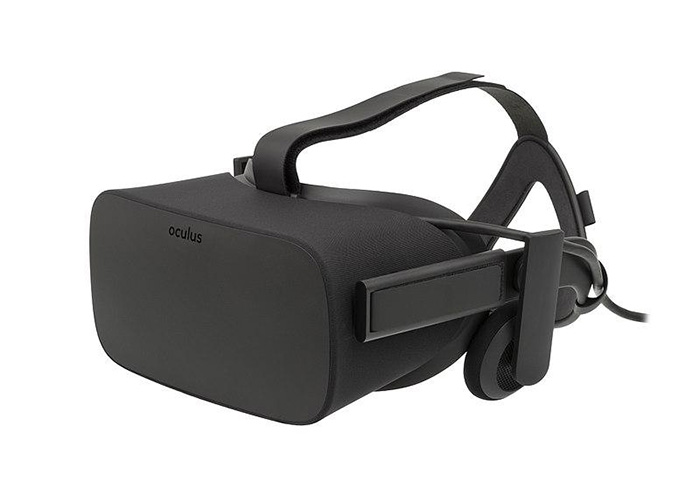
An example of a stand-alone (active) headset: Oculus Rift (source)
- Headsets for smartphones: these “passive” headsets have no electronic components. They require the use of a smartphone, which allows viewing 360 videos online or via a mobile application. This type of headset usually offers settings to adjust the focus of the image.
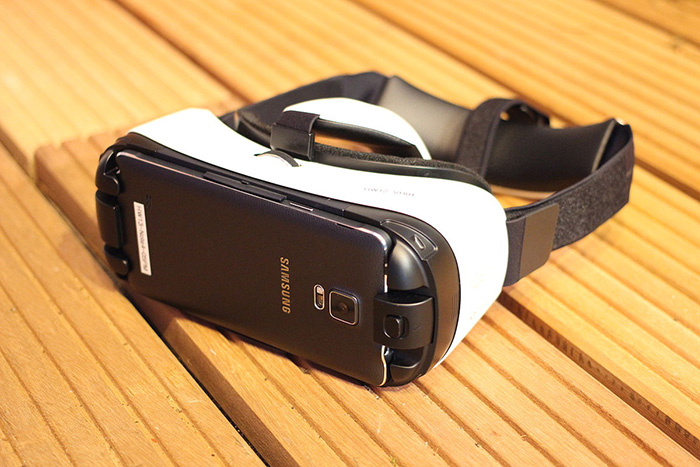
An example of a headset for smartphones: Samsung Gear VR (source)
- Basic viewers: they also require the use of a smartphone to view 360 videos. The user must hold the viewer in their hands and there are few possible adjustments, which makes the experience less immersive. Their affordability makes them an interesting option in education. Some models, such as cardboard viewers, can be assembled in minutes. However, this material makes them less durable.
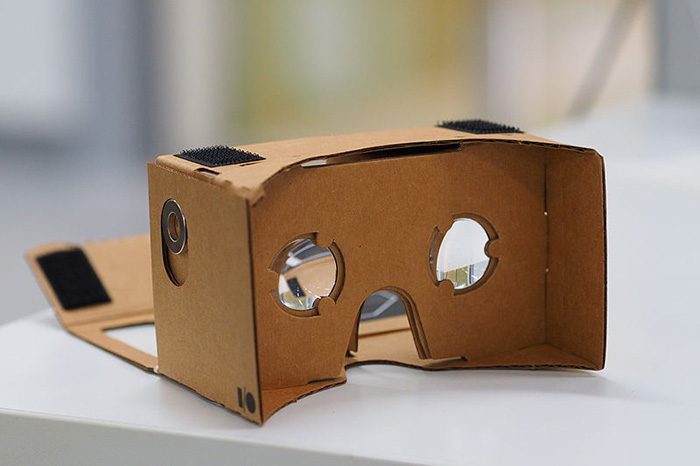
Example of a basic viewer for smartphones: Google Cardboard (source)
Smartphones
Since the most affordable viewing devices require the use of a smartphone, it is important to ensure that students have one at hand to view virtual reality content.Students can also use their smartphones to produce a 360 environment using applications such as Google Street View, Cardboard Camera or StorySpheres.
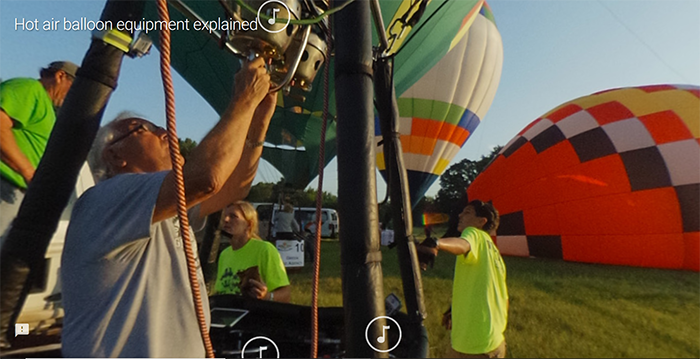
Screenshot of a virtual reality environment including audio on StorySpheres. To activate the narration, the user directs his eyes towards one of the icons (musical note). The added narrative helps identify and explain each of the components of a hot air balloon. Click here to preview it on your computer or mobile device.
360 Content
Virtual reality environments can be realistic or simulated. We mainly selected examples of realistic content, but several games and simulators also offer educational value.Here are some mobile apps and YouTube channels to view or produce free content for virtual reality.
Mobile Applications
- Cardboard Camera
- Discovery VR
- ExploreVR
- Facebook 360
- Google Cardboard
- Google Earth VR
- Google Expeditions
- HistoryView VR
- New York Times VR (NYTVR)
- Street View
- StorySpheres
- United Nations VR (UNVR)
- Within
YouTube Channels
Let’s now explore some pedagogical uses of virtual reality in college teaching.
The Example of Pascale and Johnathan: Virtual Reality to Evoke Empathy
Jonathan and Pascale experimented with virtual reality in the classroom during the 2017-2018 year thanks to a Saltise mini grant. They took advantage of the immersive potential of virtual reality to spark student empathy.Pascale wanted to support her students in Special Care Counselling in their development of interpersonal skills, particularly by raising awareness of the reality of minorities and vulnerable groups. Johnathan wanted to inspire greater student engagement when addressing ethical issues in his Contemporary Ethical and Political Issues course, even when the subject seemed far from the students’ reality.Using the Within application and smartphone viewers, students watched short 360 documentaries showing the daily lives of war refugees.
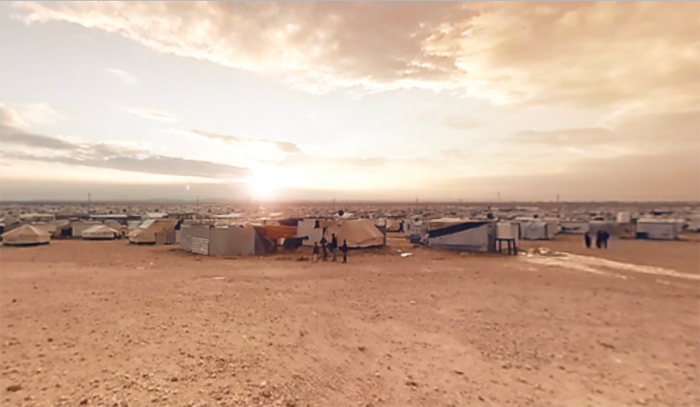
One of the 360 documentaries viewed by students, Clouds over Sidra, presents the daily life of a 12-year-old Syrian refugee in the Zaatari camp in Jordan.
This experience allowed students to get a less theoretical and more experiential understanding of conflict and its impacts on vulnerable populations, providing added value to their learning.
Other Pedagogical Uses
By competency or ability to be developed by the student
- Visual representation
- “Visiting” remote or inaccessible places
- Visualizing microscopic particles or elements that are more difficult to understand from a book, a plan or an anatomical chart
- Observing visual effects related to the creation of graphic content
- Procedural competencies
- Repeating the steps of a complex procedure
- Practising dealing with emergencies or riskful situations
- Relational skills
- Learning to interact with particular clients
- Developing empathy
- Managing emotions
- Overcoming the fear of public speaking or stage fright before an artistic performance
- Improving communication skills by practising in front of a virtual audience
- Preparing for the emotional load inherent in certain professions
- Acquisition of specific vocabulary
- Using field-specific terminology to identify elements that are part of the 360 environment. This terminology may relate to the place itself (building, museum, public square) or to the objects found there (laboratory, factory, transportation equipment, etc.)
- Creating a guided tour of a 360 location in a second language.
By Subject Matter
Marie-Ève Lapolice, a high school teacher and researcher at UQAM, has produced a directory on virtual reality in education [in French]. At the time of publishing this article, the directory proposed pedagogical uses of virtual reality (adaptable to the college level) for the following disciplines:
- Mathematics
- French
- Second language learning
- Elementary social sciences and ERC (geography, history, religious culture)
- Science (chemistry, physics)
- Arts
- Professional training (see suggestions concerning internships)
- Special education
Benefits and Disadvantages of Virtual Reality in Teaching
Main Benefits
- Increases student motivation because of its innovative aspect
- Promotes the retention of information in a sustainable way by appealing to the senses and emotions
- Avoids any real consequences in case of error
- Modulates certain emotions in a realistic context
- Allows “visiting” real or unlikely places without economic constraints or physical barriers
Main Disadvantages
- Can cause discomfort like motion sickness in some people
- Offers little interaction between people
- Requires a strong enough Wi-Fi network to support simultaneous viewing of 360 content by students
- Currently offers little free content that is both of good quality and relevant to teaching
- Does not allow many possibilities for content creation yet, due to the high cost of 360 cameras
Further Exploration
The characteristics of virtual reality that make it an entertaining experience also offer interesting pedagogical possibilities, allowing students to experience an immersive situation that would be difficult to recreate in real life. The offer of accessories and content, which remains to be expanded, is interesting enough to design a learning scenario using virtual reality in a relevant way. Most of the students surveyed in Pascale’s and Johnathan’s classes appreciated their experience, which had a positive impact on their motivation and learning.Do you see other possible pedagogical uses for virtual reality? Do you know of other free resources? Feel free to share them in the comments.

